Nowruz, the Persian New Year, is a vibrant and ancient celebration that marks the arrival of spring and the renewal of life. This joyous festival is steeped in history and cherished by millions worldwide. This article in Parsi Tours Iran travel agency will delve into the rich traditions, history, and significance of this momentous occasion, exploring the customs, food, and festivities that make this holiday a unique and cherished event.
The History of Nowruz
Nowruz, which translates to “New Day” in Persian, is the Persian New Year that falls on the first day of spring, typically around March 20th or 21st and continues for about two weeks. It’s a time for Iranians and various other communities worldwide to come together and celebrate the rebirth of nature.
It has a history dating back over 3,000 years, and Its origins can be traced to ancient Zoroastrianism, one of the world’s oldest religions. The festival was initially celebrated in ancient Persia and has survived various cultural and religious changes over the millennia.
Counting Down to Spring’s Arrival
As the winter frost begins to loosen its grip and the days grow longer, anticipation fills the hearts of those celebrating Nowruz. In this section, we delve into the various traditions leading up to the grand arrival of spring.
Spring Cleaning (Khaaneh Tekaani)
As the Iranian New Year, Nowruz, draws near, homes in Iran undergo a transformative process known as “Khane Tekani” or spring cleaning. It extends beyond mere tidying, representing a profound renewal. Families embark on a collective mission to cleanse their living spaces, physically and spiritually. This ritual symbolizes purging negativity and preparing for a fresh start in the New Year.
In parallel with this, the tradition of Sabzeh growing takes place. Sabzeh sprouted wheat or barley symbolizes rebirth and growth. Families soak grains and carefully nurture the sprouts, later displayed on the Haft-Seen table. The Sabzeh tray represents nature’s reawakening and a hopeful wish for abundance in the coming year.
New Year’s Shopping
In the days leading up to the new year, markets and bazaars bustle with activity as people prepare for the festivities. New clothes, special foods, and gifts are purchased to mark the occasion. This shopping tradition adds to the excitement and joy of the approaching new year.
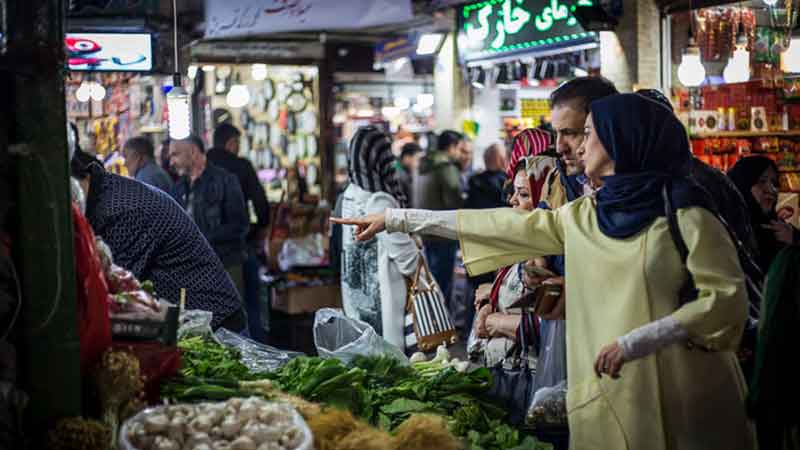
Persian new year: shopping
In bustling markets, families and individuals select vibrant outfits symbolizing fresh starts, often in lively colors reflecting the New Year’s renewal spirit. Equally significant is food shopping, with carefully chosen ingredients for traditional dishes, including fresh fruits, vegetables, nuts, seeds, and sweets. Gift-giving, a central part of this spree, spreads joy and love, reinforcing a sense of togetherness and boundless generosity.
Ghashogh-Zani (Spoon Beating)
Ghashogh-Zani is a traditional Iranian custom observed on the eve of Chaharshanbe Suri before the Iranian New Year. In this lively tradition, children and teenagers don disguises, covering their faces, and visit neighbors’ homes. They carry pots or pans and playfully request treats from the homeowners by rhythmically beating these utensils with spoons.
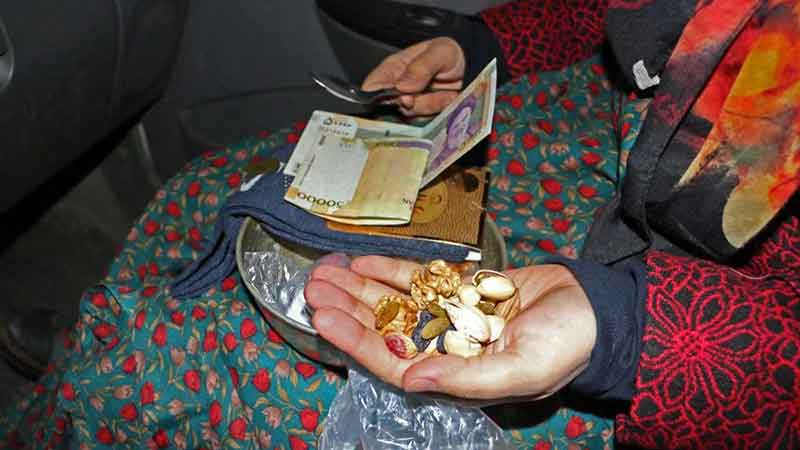
Nowruz: Ghashogh-Zani
In a manner somewhat reminiscent of Halloween’s “trick or treat,” the homeowners respond to the Ghashogh-Zani participants by offering them treats, including snacks, dried fruits, nuts, or even small amounts of cash. This festive tradition adds an element of surprise and camaraderie to the lead-up to the new year, with the sounds of clinking spoons and laughter filling the air as neighbors come together to share in the festivities.
Chaharshanbe Suri: The Festival of Fire
Chaharshanbe Suri, also known as the Festival of Fire, is a vibrant and ancient Iranian celebration on the last Tuesday of the year before the Persian New Year. This lively event is a symbolic cleansing and purification ritual where people gather to jump over bonfires and light fireworks.
During Chaharshanbe Suri, people gather outdoors to leap over bonfires, symbolizing the abandonment of past troubles for a fresh start. Families and communities unite, dancing, savoring unique dishes, and marveling at colorful fireworks in the night sky. This celebration fills the air with laughter, warmth, and the crackling of flames, all signaling the arrival of the New Year filled with hope and happiness
Setting The Haft-Seen Table
A central focus of Nowruz’s preparations is creating the Haft-Seen table. This beautifully adorned table features seven symbolic items, each starting with the Persian letter “S.” These items include Sabzeh (sprouted wheat or barley), Samanu (sweet pudding), Senjed (dried oleaster fruit), Seer (garlic), Seeb (apple), Somāq (sumac), and Serkeh (vinegar). The Haft-Seen table serves as a visual representation of the hopes and aspirations for the year ahead.
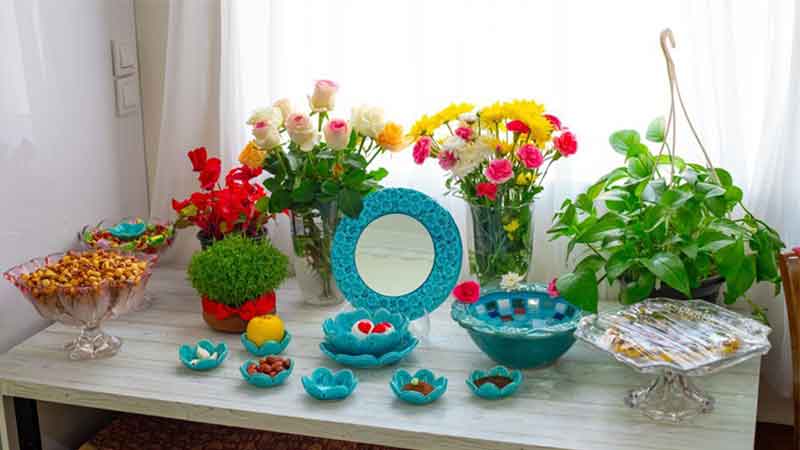
Persian new year: the Haft-Seen table
The Haft-Seen table is a masterpiece of symbolism and aesthetics. Each item on the table carries a profound meaning. Sabzeh, for example, represents rebirth and growth, while Samanu symbolizes power and strength. The table also includes a mirror, candles, painted eggs, and goldfish, each contributing to the rich tapestry of New Year’s traditions.
This beautiful tableau is a feast for the eyes and a reflection of the values and hopes cherished by those celebrating the new year. It’s a reminder of the importance of family, renewal, and the enduring spirit of this ancient holiday.
The Significance of Turn of the Year
The Persian New Year, holds profound significance that transcends the mere flip of a calendar page. It is determined by the vernal equinox, a celestial event where day and night find perfect balance, heralding the arrival of spring in the Northern Hemisphere. This transition not only marks a change in the date but signals a profound shift in the seasons, symbolizing renewal and growth.
It is more than a date; it’s a collective experience etched in the hearts of the Persian people. As the season changes, a special prayer is offered, and everyone strives to be awake and dressed, ready to welcome the New Year. This shared commitment underscores the cultural importance of this moment, a gesture of unity in embracing fresh beginnings.
After the turn of the year, cherished customs come to life. People exchange warm embraces and heartfelt gifts, often from elders to the younger generation. Additionally, the age-old tradition of reading from revered texts such as the Quran or the poetry of Hafez takes center stage. Thus, these moments become a holistic experience, weaving together astronomy, culture, spirituality, and unity in a tapestry of hope and renewal.
Celebrating the Fresh Start
The new Persian year begins after New Year’s Eve, and there are other cherished traditions to do during the holiday. This section delves into the various rituals during the first two weeks of the new Persian year.
New Year Cuisines
One of the most delightful aspects of celebrating The Persian New Year is the sumptuous array of cuisines that grace the tables of Iranian households during this festive season. These dishes are delicious and rich in symbolism, reflecting the themes of renewal and prosperity that lie at the heart of New Year’s celebrations.
Sabzi Polo Mahi (Herb Rice with Fish)
Sabzi Polo Mahi, a beloved New Year’s dish, is a flavorful blend of rice, fresh herbs, and fish. The rice is typically seasoned with fragrant herbs like dill, parsley, and coriander, giving it a vibrant green color. The fish, often whitefish or smoked fish, symbolizes abundance and good fortune. This dish is a culinary celebration of the arrival of spring and the hope for a bountiful year ahead.
Ash Reshteh (Noodle Soup)
Ash Reshteh is a hearty noodle soup that finds its way to tables in new year’s cuisines. It’s made with ingredients, including legumes, herbs, and noodles. Ash Reshteh is often garnished with Kashk, a fermented whey sauce, and fried mint, adding layers of flavor to this comforting soup.
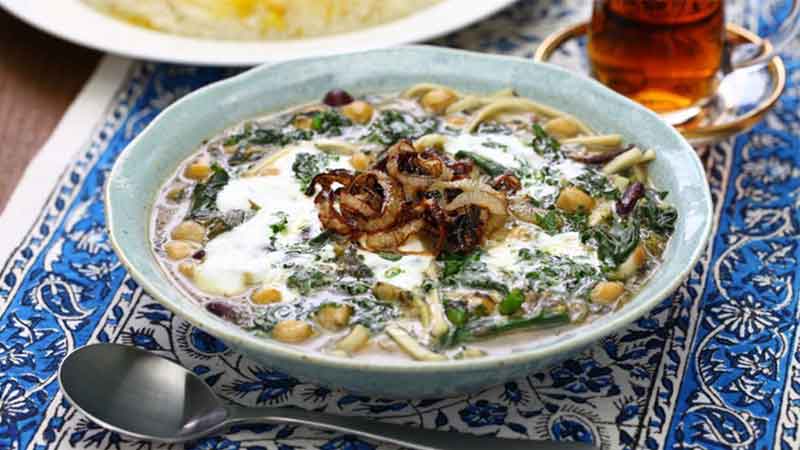
Nowruz: Ash Reshteh
Sweets and Pastries
No Iranian celebration is complete without an assortment of sweets and pastries. During the New Year holiday, households are filled with a dazzling array of confections, from baklava to gaz (nougat). These sweet treats are shared with guests and symbolize the sweetness of life and the joys of togetherness.
Visiting Family and friends
One of the most heartwarming and treasured traditions during the New Year holiday is visiting Family and friends, with particular attention given to the elderly members of the community. This practice embodies the essence of Nowruz, emphasizing the importance of maintaining close bonds with loved ones and showing respect to those who have accumulated wisdom over the years.
Visiting older people is particularly significant, as it is a gesture of reverence and gratitude for their guidance and wisdom. Elders, in return, bestow blessings and good wishes upon the younger generations. It’s a time when the generations bridge the gap, stories are shared, laughter is abundant, and love is palpable.
Traveling
Traveling during the Persian New Year’s holiday captures the excitement and emphasis on togetherness. Families and friends unite for celebrations, often embarking on journeys to reunite with loved ones in different regions. This tradition offers a chance to explore the country and reconnect with distant relatives.
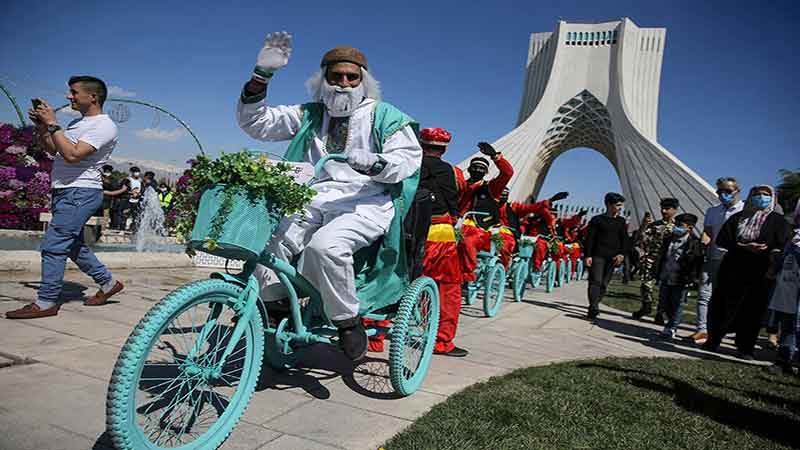
Persian new year : traveling
The roads and airports are bustling with travelers heading to their hometowns and tourist destinations during this period. Whether visiting historic sites, exploring the countryside, or reuniting with family, travel is a meaningful way to celebrate, create lasting memories, and embrace the spirit of togetherness and adventure that defines this festive season.
Conclusion
The Persian New Year is a vibrant and culturally rich festival that celebrates spring’s arrival and life’s renewal. With its ancient history, unique traditions, and delicious cuisine, it is a time for joy, reflection, and strengthening bonds with loved ones.



